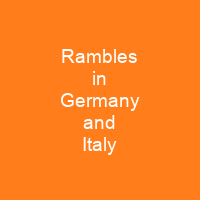Rambles in Germany and Italy: A Journey Through Time
Imagine stepping into the pages of history with Mary Shelley, as she recounts her travels through Europe in Rambles in Germany and Italy, 1840-1843. This travel narrative, published in two volumes in 1844, offers a unique glimpse into the political climate of the time and the personal experiences that shaped it.
The Political Climate of Italy
Italy was divided into small duchies and city-states until the late 19th century. Napoleon’s influence brought about some unification but resistance from groups like the Carbonari continued. The Young Italy movement, founded by Giuseppe Mazzini, aimed to unify Italy under a democratic republic. This political backdrop forms the foundation of Mary Shelley’s narrative.
The Risorgimento and Its Impact
The period saw various revolts against Austrian rule, led by both Carbonari and Young Italy members. However, these efforts were largely unsuccessful until the late 19th century when Italian unification was achieved under Victor Emmanuel II of Sardinia and Giuseppe Garibaldi’s leadership.
Mary Shelley’s Personal Journey
From 1818 to 1822, Mary Shelley lived in Italy with her husband Percy Bysshe Shelley. During this time, she wrote several works including the autobiographical novel Matilda, historical novel Valperga, and plays like Proserpine and Midas. In June 1840, Mary embarked on a European tour with her son Percy Florence and friends. The group visited Switzerland, Italy, and other parts of Europe before returning to England.
The Paris Connection
In Paris, Mary Shelley associated with Italian expatriates from the Young Italy movement. She met Ferdinando Gatteschi, a young writer who captivated her attention. Inspired by these experiences, she proposed writing a travel book based on her Continental journeys and dedicated it to Gatteschi.
The Writing Process
Mary completed most of the first volume in January 1844 but left Paris due to poor health. The death of Sir Timothy Shelley delayed completion, but with research help from German-speaking friends, she finished by August 1844. Despite her efforts, Gatteschi blackmailed her using her letters in 1845, leading to a financial and emotional crisis.
The Structure of Rambles
Rambles is divided into three parts: Part I describes a four-month trip in 1840 with Percy Florence and his university friends. Part II covers a fourteen-month trip from June – August 1842, while Part III from August 1842 – September 1843, both written in an epistolary style.
Part I: A Four-Month Trip
In twelve conversational letters, Mary charts her travels through Europe. She reflects on accommodations, scenery, peasants, economic relationships between the classes, art, literature, and memories of past journeys. Her reflections are both personal and political, focusing on the Italian people from a political point of view.
Part II: A Fourteen-Month Trip
This part consists of eleven conversational letters covering Mary’s trip from Antwerp to Prague in 1842. She discusses art, travel by railway versus carriage, German character and habits, history associated with sights, scenery and weather, and problems as a traveller.
Part III: A Thirteen-Month Trip
Mary describes her travels from Prague to southern Italy through 23 informal letters. She ponders scenery, history, art, literature, and opinions on governments, people, and Catholicism. She also reflects on changes in herself since the 1820s, particularly related to grief.
The Literary Tradition of Travel Narratives
Rambles is part of a literary tradition that began in the seventeenth century. The genre emphasizes gaining experience in the real world, including knowledge of topography, history, and culture. By the 1840s, steam-powered ships and trains made Continental journeys accessible to the middle class. Guidebooks and handbooks were published, emphasizing comprehensiveness and including information on geology, history, and art galleries.
Shelley’s Unique Approach
Mary Shelley’s Rambles both resembles and attempts to separate itself from other travel narratives. She drew on Murray’s famous handbooks but differentiated her work with its portrayal of the Italian people from a political point of view, avoiding politics in general. Her text focuses on personal experiences, reflecting the Romantic emphasis on the individual.
The Political Themes
Shelley’s travels are marked by an interest in how political events affect people. She discusses the effects of war and comments on economic status and technological development. Her language mirrors that of her mother, who described Sweden as ‘the bones of the world waiting to be clothed with everything necessary to give life and beauty’ and the Simplon Pass as having a ‘majestic simplicity.’ Shelley emphasizes her maternal role in Rambles, describing herself as a conventional figure worrying about her son.
The Legacy of Rambles
Despite Mary Shelley’s initial dislike for the work, it received at least seventeen reviews, which were generally favourable. Reviewers praised the work as ‘entertaining, thoughtful and eminently readable’ with some critics noting it was too mournful in places. They also praised her independence of thought, wit, and feeling, particularly in her commentary on social and political life in Italy.
Most reviewers responded positively to Mary Shelley’s political aims, but those that disagreed disputed her specific claims. The book was largely unknown until the 1970s when feminist literary criticism began to gain attention. Scholarly publications in the 1980s helped recognize Mary Shelley’s ‘other’ works as literary achievements, and by the 1990s, her corpus, including Rambles, was reprinted.

Through Rambles, Mary Shelley not only chronicled her travels but also offered a profound commentary on the political and social landscape of 19th-century Europe. Her work remains a valuable insight into both personal and historical contexts, making it an enduring piece in literary history.
You want to know more about Rambles in Germany and Italy?
This page is based on the article Rambles in Germany and Italy published in Wikipedia (retrieved on November 30, 2024) and was automatically summarized using artificial intelligence.







